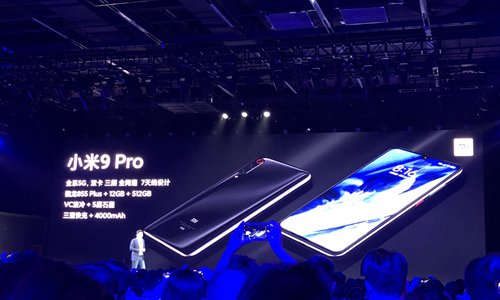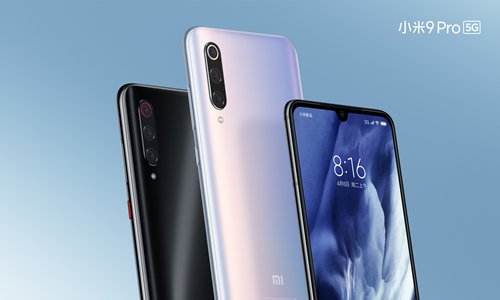HOME >> BUSINESS
Xiaomi unveils 5G smartphones to gain foothold in competitive market
By Zhang Hongpei Source:Global Times Published: 2019/9/24 19:48:41

Xiaomi unveiled its first 5G smartphone for the Chinese market the Xiaomi 9 Pro on Tuesday in Beijing. Photo: Zhang Hongpei/GT

A view of Xiaomi 9 Pro smartphones Photo: Courtesy of Xiaomi

A view of Xiaomi's Mi MIX Alpha concept smartphone released on Tuesday Photo: Courtesy of Xiaomi
China's tech giant Xiaomi unveiled its first 5G smartphone for the Chinese market - the Xiaomi 9 Pro - on Tuesday amid rising competition in domestic 5G smartphone launches this year.
It is Xiaomi's second 5G-compatible smartphone globally. It launched its first, the Mi MIX 3 5G, in February this year during the MWC 2019, held in Spain.
Working closely with China Mobile, China Unicom and China Telecom - China's three major telecom operators - the Mi 9 Pro 5G provides full coverage on the mainstream 5G bands used in the Chinese mainland, including the existing N41 and N78 frequency bands, and China Mobile's N79 5G band.
The Xiaomi 9 Pro handset can download 100 songs within three seconds, 10 times faster than the 4G standard, said Lei Jun, Xiaomi's founder and CEO, during the launch event.
It comes equipped with a 6.39-inch AMOLED display and features a triple camera setup which includes a 48-megapixel main sensor and a 20-megapixel front camera.
Powered by Qualcomm's Snapdragon 855 Plus chipset and a 4000mAh-capacity battery with 30W wireless charging support, the Xiaomi 9 Pro can be charged to 100 percent battery in 69 minutes.
"Wireless charging has become a standard configuration in the 5G network era," said Lei.
Additionally, the flagship Xiaomi 9 Pro can charge other smartphones like the iPhone via a reverse wireless method.
With a 3,699 yuan ($520) starting price, the Xiaomi 9 Pro is thus far the cheapest 5G handset on the Chinese market. It is cheaper than the iQOO 5G smartphone unveiled by Shenzhen-based smartphone vendor Vivo on August 22, which starts at 3,798 yuan.
Chinese smartphone vendors have been racing to roll out their cutting-edge, next-generation products to gain a foothold in the increasingly competitive market. They have been adopting aggressive pricing strategies to attract more consumers and win traction in the huge 5G market, which is set to embrace explosive growth in the coming years, analysts said.
James Yan, the Beijing-based research director at Counterpoint, told the Global Times on Tuesday at the launch event that compared with 4G smartphones, vendors need to increase prices by around $80 for material costs. "So the pricing of the Xiaomi 9 Pro can generally cover its costs," said Yan.
"As far as I am concerned, most domestic vendors won't stock many 5G handsets at the moment as the technology is still at an early stage, but these players cannot wait to capture market share in advance," said Yan.
Besides, as China's telecommunications authority has confirmed the large-scale rollout of the standalone type (SA) network of 5G next year, it is also unwise to produce many at the moment, according to Yan.
China's Minister of Industry and Information Technology Miao Wei said at a press conference on Friday that most 5G phones have adapted to the non-standalone (NSA) type, while the real mode to reflect 5G networks is through the SA type.
NSA and SA are two types of 5G networks.
Thus far, only Huawei's 5G smartphones can support the two types. In June, Huawei's Mate 20 X became the first model to receive a 5G license in China, and the product, being the first to support both SA and NSA, officially hit stores on August 16.
Huawei's Kirin 990 is the most powerful 5G System-on-chip (SoC), the world's first chipset supporting the two types.
Xiaomi announced on Tuesday its Mi MIX Alpha concept smartphone in the 5G era. It features a surround screen with a screen-to-body ratio of more than 180.6 percent.
Posted in: COMPANIES